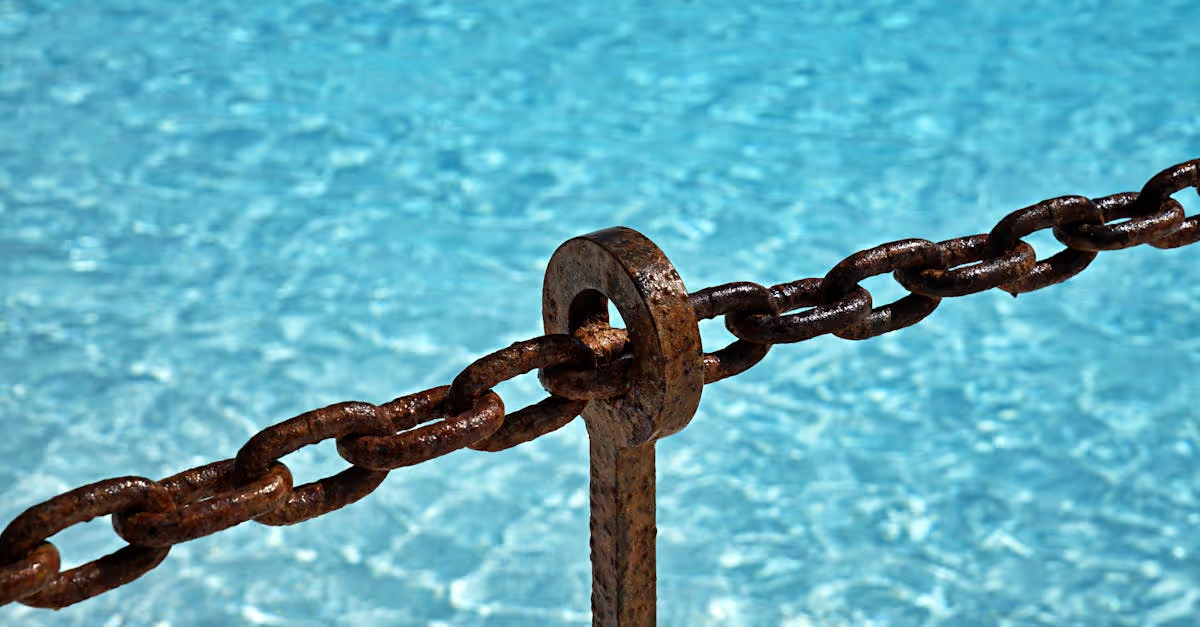Key Takeaways
- Protection From Debris: Winter pool covers shield pools from leaves and dirt, reducing algae growth and minimizing spring cleaning efforts.
- Energy Efficiency: Thermal covers significantly retain heat, potentially cutting heating costs by up to 50%, allowing for comfortable, occasional winter swims.
- Safety Considerations: Safety covers support weight and prevent accidents, providing peace of mind for families with children and pets during the off-season.
- Types of Covers Available: Understanding the different cover types—safety, thermal, and mesh—allows for informed choices based on specific needs and pool conditions.
- Installation Steps: Proper preparation and installation steps are crucial for optimal cover performance, including pool cleaning, water level adjustment, and secure anchoring.
- Maintenance Essentials: Regular inspections and cleaning of winter covers enhance their lifespan and ensure continued protection throughout the winter months.
As winter approaches, protecting our pools becomes essential. Did you know that a well-installed winter pool cover can reduce maintenance costs by up to 50%? With temperatures dropping and debris falling, taking the right steps now ensures our pools stay in top shape for next summer.
Types of Winter Pool Covers
Various pool cover options exist, each serving specific needs and preferences. We’ll explore three primary types: safety covers, thermal covers, and mesh covers.
Safety Covers
Safety covers provide solid protection for both pools and passersby. Made from durable materials, these covers can support weight, keeping children and pets safe. They’re particularly useful for homes with active families. Safety covers come in two types: solid and mesh. Solid covers block sunlight and debris, reducing algae growth, while mesh covers allow water to drain through. Choosing a safety cover enhances peace of mind and contributes to pool maintenance.
Thermal Covers
Thermal covers play a crucial role in retaining heat. They prevent heat loss by trapping warmth and minimizing evaporation. Using a thermal cover can reduce heating costs by up to 50%. These covers come in various materials, including bubble and insulated layers, each providing different levels of insulation. For those hoping to extend swim seasons, thermal covers are worth considering. They help maintain a comfortable pool temperature, making dips in chilly months more enjoyable.
Mesh Covers
Mesh covers offer a blend of visibility and safety. They let rainwater and debris filter through while keeping large objects out. Such covers simplify maintenance; we typically don’t worry about water accumulating on top. They come in several designs that cater to various pool shapes and sizes. If we prioritize safety with an eye on efficiency, mesh covers present an effective solution. They balance security and convenience, allowing us to enjoy our pools hassle-free during winter months.
Benefits of Winter Pool Covers
Winter pool covers offer multiple advantages, making them essential for off-season pool management. These covers help in protecting our pools from several factors while enhancing efficiency and safety.
Protection from Debris
Winter pool covers prevent leaves, twigs, and dirt from entering the water. Accumulating debris can lead to algae growth and complicate spring cleaning. Covers act as shields, keeping our pools cleaner and reducing maintenance time. Imagine waking up in spring to a pool that's more inviting than a bowl of fresh fruit—it saves us work and elevates our pool experience.
Energy Efficiency
Winter pool covers also improve energy efficiency. Thermal covers, in particular, retain heat, reducing heating costs by up to 50%. This means less money spent on heating systems, allowing us to keep our pools warmer for that occasional winter dip. Think of it as a cozy blanket for our pool—who doesn’t love the idea of swimming in mild temperatures during the chilly months?
Safety Considerations
Safety is another significant benefit. Safety covers support the weight of children and pets, preventing accidents. They provide peace of mind for families, especially those with young ones. Ensuring our loved ones are safe during the off-season gives us confidence to relax. We can all agree that a covered pool reduces worries—nothing compares to knowing our pool’s off-limits, unless we choose to dive in.
Winter pool covers offer essential protection, energy savings, and enhanced safety—key factors that contribute to successful off-season care for our pools.
Steps for Installing Winter Pool Covers
Installing a winter pool cover involves a series of straightforward steps. Each step keeps our pools in top shape during the chilly months.
Preparing the Pool
First, we clean the pool. A clear surface helps prevent debris from staining the cover. We remove leaves, dirt, and any other items that may have collected. Next, we take off any accessories like ladders or diving boards. Removing these prolongs their lifespan and keeps them safe. Then, we balance the pool's chemistry. Testing and adjusting the water levels helps stop algae from growing. Finally, we lower the water level in the pool to the recommended height. This prevents damage caused by freezing water.
Choosing the Right Cover
Selecting the right winter pool cover matters. We have options like safety covers, thermal covers, and mesh covers. Safety covers support weight and protect pets and children while limiting algae growth. Thermal covers save us heating costs by retaining warm water. Mesh covers filter rainwater while keeping debris out, which simplifies maintenance. Each cover type serves its purpose, so we consider our specific needs when deciding.
Installation Process
When installing the cover, we start at one end of the pool. Position the cover over the pool, centering it to reduce adjustments. We then attach the cover to anchors or use water bags along the edges. This secures it against strong winds. After securing the cover, we check for any loose areas and adjust as needed. Finally, we take one more look to ensure everything looks solid. A properly installed cover protects our pools and saves us effort during the off-season.
Maintenance Tips for Winter Pool Covers
Maintaining winter pool covers is vital for prolonging their lifespan and ensuring effective protection throughout the season. Here are some key practices we recommend.
Regular Inspections
Conducting regular inspections helps us catch any issues before they escalate. We should check the cover's surface for signs of wear or damage. Look for tears, holes, or fraying edges. Verify that the anchors and straps remain securely fastened. If we notice anything amiss, addressing it promptly prevents further complications. Consider checking at least once a month, especially after storms or heavy snowfall. Keeping a keen eye on our cover helps us avoid unexpected repairs in the spring when we’re eager to open the pool.
Cleaning Procedures
Cleaning the cover regularly contributes to its durability. We recommend using a soft brush or leaf blower to remove debris like leaves and twigs. For stubborn stains or algae, a mild soap solution followed by rinsing with water keeps the cover looking fresh. If dirt builds up, it may seep through and create future problems. Let’s not forget to clear off snow accumulations too, which can add extra weight and strain the cover. Invest a little time each month into cleaning, and our covers will thank us come spring!
By keeping up with these maintenance tips, we maintain our pool cover's efficiency and effectiveness throughout winter.
Conclusion
Installing a winter pool cover is a smart investment for protecting our pools during the off-season. By choosing the right type of cover and following proper installation and maintenance steps, we can significantly reduce maintenance costs and ensure our pools remain in excellent condition for the next swim season.
Regular inspections and cleaning keep our covers functional and extend their lifespan. With safety and energy efficiency in mind, we’re not just safeguarding our pools but also enhancing our overall experience when summer returns. Embracing these proactive measures allows us to enjoy our pools with peace of mind, knowing we’ve taken the right steps to protect our investment.
Frequently Asked Questions
Why is it important to cover my pool in winter?
Covering your pool in winter protects it from debris and algae growth, lowering maintenance costs by up to 50%. It also safeguards against freezing damage and enhances safety for children and pets.
What types of winter pool covers are available?
There are three main types of winter pool covers: safety covers, thermal covers, and mesh covers. Each serves different needs, from safety and heat retention to maintenance ease.
How do safety covers work?
Safety covers are designed to support weight, preventing accidents involving children and pets. They also reduce algae growth by keeping debris out of the pool.
What are thermal covers used for?
Thermal covers are essential for retaining heat in your pool, which can cut heating costs by up to 50%. They help extend the swim season by keeping the water warmer.
How do mesh covers benefit pool owners?
Mesh covers allow rainwater and debris to filter through while keeping the pool protected. They provide visibility and reduce maintenance efforts, making them a popular choice.
What should I do before installing a winter pool cover?
Before installing a winter cover, clean the pool, remove accessories, balance the water chemistry, and lower the water level to prevent freezing damage.
How often should I inspect my winter pool cover?
Inspect your winter pool cover at least once a month, especially after storms. Look for wear or damage to the cover and its anchors and straps to ensure safety and effectiveness.
How do I clean my winter pool cover?
To clean your winter pool cover, use a soft brush or leaf blower to remove debris, and apply a mild soap solution for stubborn stains. Regular cleaning helps prolong the cover's lifespan.






.svg)
.svg)